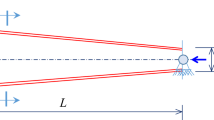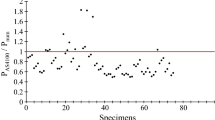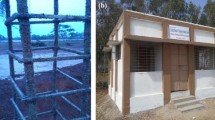Abstract
Artificial neural networks (ANN) are artificial intelligence technologies used in various fields of science and engineering to represent fascinating human behaviours. Engineers frequently deal with incomplete and noisy data, which is one of the areas where neural network (NN) shine. Aim of this study is to use an ANN approach to determine the rotation capacity of open web steel beams. Using a single point load applied at the span's centre, a theoretical, experimental, and analytical study was conducted. Following the results of experimental and analytical comparisons, the ABAQUS software tool was used to assess a total of 88 nonlinear finite element models. Local slenderness ratios of several finite element models differentiate them. Different elements comprising geometrical and mechanical features of open web steel beams were delivered as input to NN models, including flange and web slenderness, depth and breadth of section, load span and angle section. Suggested formulation's accuracy is confirmed by arithmetical regression created using analytical nonlinear finite element modelling and behaviour of the open web steel beam derived analytically was tested experimentally. Based on research and statistical analysis, the current study found that ANN has a great potential for forecasting the rotation capacity of open web steel beams.










Similar content being viewed by others
References
Adeli, H., & Yeh, C. (1989). Perceptron learning in engineering design. Computer Aided Civil Infrastructure Engieering, 4, 247–256.
AISC 360-16. Specification for Structural Steel Buildings, an American National Standard. Am. Inst. Steel Constr. Chicago 612 (2016).
Al-Jabri, K. S., Al-Alawi, S. M., Al-Saidy, A. H., & Alnuaimi, A. S. (2007). Predicting the behaviour of semi-rigid joints in fire using an artificial neural network. Steel Structure, 7, 209–217.
Anastasiadis, A., Mosoarca, M., & Gioncu, V. (2012). Prediction of available rotation capacity and ductility of wide-flange beams: Part 2: Applications. Journal of Constructional Steel Research, 68, 176–191.
Badawi, M. W., Mohsin, M. E., & Thornley, R. H. (1963). The static analysis of warren beams under torsional and bending loads. International Journal of Machine Tool Design and Research, 3, 177–191.
Baker, J. & Heyman, J. Plastic Design of Frames 1. Fundamental. (1969).
Bild, S., Roik, K., Sedlacek, G., Stutzki, C., & Spangemacher, R. Background document for chapter 5 of Eurocode 3—the b/t-ratios controlling the applicability of analysis models in Eurocode 3. Aachen: Draft. (1989).
BS 5950-1:1990. Structural use of steelwork in building. Part 1. Code of practice for design in simple and continuous construction: hot rolled sections. (1990).
Cevik, A. (2007). Genetic programming based formulation of rotation capacity of wide flange beams. Journal of Constructional Steel Research, 63, 884–893.
CSA S16-09. Design of Steel Structures. (2009).
D’Aniello, M., Guneyisi, E. M., Landolfo, R., & Mermerdaş, K. (2014). Analytical prediction of available rotation capacity of cold-formed rectangular and square hollow section beams. Thin-Walled Structure, 77, 141–152.
dei Lavori Pubblici, C. S. Norme tecniche per le costruzioni. Gazz. Uff. 495 (2008).
DIN 18800-1. Steel structures - Part 1: Design and construction. (1990).
El-Kassas, E. M. A., Mackie, R. I., & El-Sheikh, A. I. (2001). Using neural networks in cold-formed steel design. Computers & Structures, 79, 1687–1696.
EN 1993-1-1. Eurocode 3: Design of steel structures - Part 1–1: General rules and rules for buildings. Eur. Comm. Stand. 1, (2005).
Fang, C., Ping, Y., Gao, Y., Zheng, Y., & Chen, Y. (2022a). Machine learning-aided multi-objective optimization of structures with hybrid braces – Framework and case study. Engineering Structures, 269, 1–24.
Fang, Z., et al. (2021a). Deep learning-based procedure for structural design of cold-formed steel channel sections with edge-stiffened and un-stiffened holes under axial compression. Thin-Walled Structure, 166, 108076.
Fang, Z., et al. (2021b). Deep learning-based axial capacity prediction for cold-formed steel channel sections using Deep Belief Network. Structures, 33, 2792–2802.
Fang, Z., Roy, K., Dai, Y., & Lim, J. B. P. (2022b). Effect of web perforations on end-two-flange web crippling behaviour of roll-formed aluminium alloy unlipped channels through experimental test, numerical simulation and deep learning. Thin-Walled Structure, 179, 109489.
Fang, Z., Roy, K., Ma, Q., Uzzaman, A., & Lim, J. B. P. (2021c). Application of deep learning method in web crippling strength prediction of cold-formed stainless steel channel sections under end-two-flange loading. Structures, 33, 2903–2942.
Gholizadeh, S., Pirmoz, A., & Attarnejad, R. (2011). Assessment of load carrying capacity of castellated steel beams by neural networks. Journal of Constructional Steel Research, 67, 770–779.
Gioncu, V., Mosoarca, M., & Anastasiadis, A. (2012). Prediction of available rotation capacity and ductility of wide-flange beams: Part 1: DUCTROT-M computer program. Journal of Constructional Steel Research, 69, 8–19.
Gulgec, N. S., Takáč, M., & Pakzad, S. N. (2019). Convolutional neural network approach for robust structural damage detection and localization. Journal of Computing in Civil Engineering, 33, 04019005.
Guneyisi, E. M., D’Aniello, M., Landolfo, R., & Mermerdaş, K. (2014). Prediction of the flexural overstrength factor for steel beams using artificial neural network. Steel & Composite Structures, 17, 215–236.
Guzelbey, I. H., Cevik, A., & Gögüş, M. T. (2006). Prediction of rotation capacity of wide flange beams using neural networks. Journal of Constructional Steel Research, 62, 950–961.
Hait, P., Sil, A., & Choudhury, S. (2020). Seismic damage assessment and prediction using artificial neural network of RC building considering irregularities. Journal of Structural Integrity and Maintenance, 5, 51–69.
Hassan, E. M., Serror, M. H., & Mourad, S. A. (2017). Numerical prediction of available rotation capacity of cold-formed steel beams. Journal of Constructional Steel Research, 128, 84–98.
IS:800-2007. Indian standard code of practice for general construction in steel. Bureau of Indian Standards, New Delhi (2007).
IS 1608 (2005): Mechanical testing of metals - Tensile Testing [MTD 3: Mechanical Testing of Metals]. (2005).
Kaczmarek, M., & Szymańska, A. (2016). Application of artificial neural networks to predict the deflections of reinforced concrete beams. Studis Geotechnica Mechanica, 38, 37–46.
Kemp, A. R. (1985). I Interaction of plastic local and lateral buckling. Journal of the Structural Engineering. American Society of Civil Engineers, 111, 2181–2196.
Mansour, M. Y., Dicleli, M., Lee, J. Y., & Zhang, J. (2004). Predicting the shear strength of reinforced concrete beams using artificial neural networks. Engineering Structures, 26, 781–799.
Matteis, G. D., Moen, L. A., Langseth, M., Landolfo, R., Hopperstad, O. S., & Mazzolani, F. M. (2001). Cross-sectional classification for aluminum beams—parametric study. Journal of the Structural Engineering. American Society of Civil Engineers, 127, 271–279.
Megson, T. H. G. (2019). Structural and stress analysis. Butterworth-Heinemann.
Pala, M., & Caglar, N. (2007). A parametric study for distortional buckling stress on cold-formed steel using a neural network. Journal of Constructional Steel Research, 63, 686–691.
Petcu, D., & Gioncu, V. (2003). Computer program for available ductility analysis of steel structures. Computers & Structures, 81, 2149–2164.
Rafiq, M. Y., Bugmann, G., & Easterbrook, D. J. (2001). Neural network design for engineering applications. Computers & Structures, 79, 1541–1552.
Rhim, J., & Lee, S. W. (1995). A neural network approach for damage detection and identification of structures. Computational Mechanics, 16, 437–443.
Saliba, N., & Gardner, L. (2013). Experimental study of the shear response of lean duplex stainless steel plate girders. Engineering Structures, 46, 375–391.
Sedlacek, G., & Feldmann, M. The b/t-ratios controlling the applicability of analysis models in Eurocode 3, Part 1.1. Background Document, 5. (1995).
Simulia. ABAQUS/CAE User’s Manual (Version 6.14). Dassault Systemes; (2014).
Standard, B. Eurocode 8: Design of structures for earthquake resistance. Part-1. (2005).
Stranghoner, N., Sedlacek, G., & Boeraeve, P. Rotation requirement and rotation capacity of rectangular, square and circular hollow section beams. Tubul. Struct. VI. Routledge. 143–150 (2021).
Timoshenko, S. P., & Gere, J. M. (1961). Theory of elastic stability. McGraw-Hill.
Topcu, I. B., & Saridemir, M. (2008). Prediction of rubberized concrete properties using artificial neural network and fuzzy logic. Construction and Building Materials, 22, 532–540.
Wilkinson, T., & Hancock, G. (2002). Predicting the rotation capacity of cold-formed RHS beams using finite element analysis. Journal of Constructional Steel Research, 58, 1455–1471.
Yang, X., Gao, Y., Fang, C., Zheng, Y., & Wang, W. (2022). Deep learning-based bolt loosening detection for wind turbine towers. Structural Control Health Monitoring, 29, e2943.
Yura, J. A., Galambos, T. V., & Ravindra, M. K. (1978). The bending resistance of steel beams. Journal of the Structural Division, 104, 1355–1370.
Zekić-Sušac, M., Šarlija, N., & Benšić, M. (2005). Selecting neural network architecture for investment profitability predictions. Journal of Information Organizational Sciences, 651, 83–95.
Author information
Authors and Affiliations
Corresponding author
Additional information
Publisher's Note
Springer Nature remains neutral with regard to jurisdictional claims in published maps and institutional affiliations.
Rights and permissions
Springer Nature or its licensor (e.g. a society or other partner) holds exclusive rights to this article under a publishing agreement with the author(s) or other rightsholder(s); author self-archiving of the accepted manuscript version of this article is solely governed by the terms of such publishing agreement and applicable law.
About this article
Cite this article
Gawande, G.S., Gupta, L.M. Rotation Capacity Prediction of Open Web Steel Beams Using Artificial Neural Networks. Int J Steel Struct 23, 1063–1076 (2023). https://doi.org/10.1007/s13296-023-00750-2
Received:
Accepted:
Published:
Issue Date:
DOI: https://doi.org/10.1007/s13296-023-00750-2




